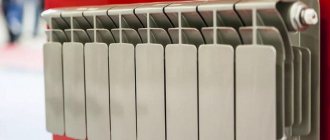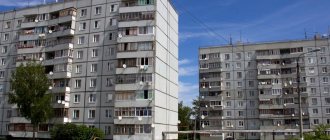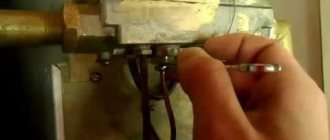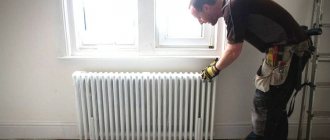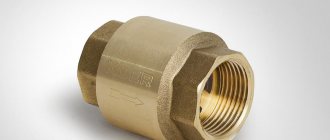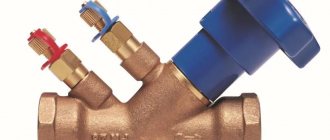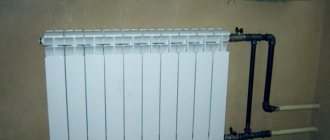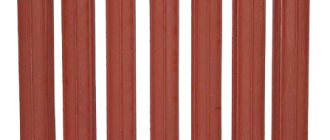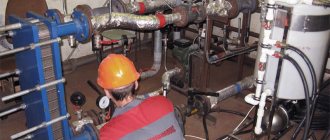Some consumers complain that the last radiator in their home does not heat. This factor causes a lot of inconvenience, because one of the rooms does not warm up and the apartment owner is forced to use additional heating equipment.
Most often, the reasons why a heating radiator does not perform its assigned functions are global and include:
- Incorrect installation or connection;
- Insufficient pressure under which coolant is supplied to the system;
- Lack of balancing.
To find out the reason, it is recommended to contact professionals, but if this is not possible, you can try to solve the problem yourself.
Additional reasons
Cases when the temperature in the apartment is low are not so rare.
The coolant may simply not reach the last radiator along the route. This may be relevant when the system is incorrectly designed, or the diameter of the pipes does not correspond to the calculated one. Quite often the ratio of water volume to intensity and circulation is selected incorrectly. If you still don’t know what to do if the batteries don’t heat well, then it’s also important to pay attention to whether the pump is doing its job. A change in the heating operating temperature can be caused by a number of internal reasons. Many of them negatively affect the efficiency of the system, increasing energy costs
In such cases, a reasonable question arises: why does the heating not heat up: radiators, batteries, pumps, systems? The first step is to find the causes of the problem.
Many of them negatively affect the efficiency of the system, increasing energy costs. In such cases, a reasonable question arises - why does the heating not heat up: radiators, batteries, pumps, systems? The first step is to find the causes of the problem.
A change in the heating operating temperature can be caused by a number of internal reasons. Many of them negatively affect the efficiency of the system, increasing energy costs. In such cases, a reasonable question arises: why does the heating not heat up: radiators, batteries, pumps, systems? The first step is to find the causes of the problem.
Why doesn't the battery warm up in a private house?
In the private sector, in addition to the above reasons for unsatisfactory heating performance, there are others. Private houses have almost 100 percent autonomous heating. The cause of poor heating may be the heating boiler. Most likely, the boiler power is calculated incorrectly; it is not enough to heat the coolant to an acceptable temperature. If the automatic boiler does not turn off, this is a sure sign of insufficient power.
Properly equipped boiler room
If the boiler is running, the liquid will still warm up. When the radiators are completely cold, the heating unit is broken or does not turn on. Modern boilers turn on when the minimum pressure level in the system is observed. The boiler will not turn on if it is less. Also, modern boilers are equipped with a security system. For example, in a gas boiler there is a sensor that is responsible for ensuring that exhaust gases go into the chimney. If for some reason the smoke does not go away completely, the automation will work, the boiler will turn off and will not turn on until the problems are corrected.
What other reasons are there why the battery in the house does not heat? The pressure in the system may be too low and, as a result, circulation is disrupted. If the batteries are old, this reason is unlikely, because two atmospheres (the usual pressure of a home system) is enough for them. But some modern batteries require higher pressure. Before installing them, it is worth looking at the passport to see if the system can create the required pressure.
You can slightly increase the pressure in the system by installing a circulation pump with an appropriate system capacity.
Since heating in private homes is often done by people who are illiterate in this regard, installation errors are possible, causing the heating to be weak. It is believed that the use of a single-pipe system saves pipes, but due to the peculiarities of the system, the heating of the batteries weakens as they move away from the boiler or they remain completely cold. In addition, batteries remote from the boiler should have more sections. It's impossible to save money.
Two-pipe system
In a private house, a two-pipe system is much more efficient, but errors are possible during its installation, which will affect the heating efficiency. Such errors include:
- incorrect installation of shut-off valves;
- incorrectly connected batteries;
- The pipe diameters were selected randomly.
With such errors, effective circulation is not ensured and the heating battery does not warm up. There is only one way out - to invite a specialist and eliminate the errors. And in order not to pay twice, initially entrust such responsible work to a proven, qualified specialist.
Methods for flushing radiators and new methods for cleaning the internal surface
During operation, the internal surface of the heating system becomes covered with rust, salt deposits, and other impurities. All this complicates the circulation of hot water and significantly reduces the air temperature in the apartment. Regular cleaning of heating radiators removes blockages and restores normal circulation of coolant.
It is possible to clean the heat exchanger, equipped with outlet and inlet taps, even during the period when the central heating is already working, but when the riser is hot, the batteries remain cold. First of all, turn off both taps, then remove the radiator using a suitable wrench and divide it into sections. The next part of the work does not require special skills - each element is washed well under a strong stream of water. If a lot of scale has accumulated inside and the sediment cannot be easily removed, you will have to deal with it using chemicals. After drying, the entire structure is assembled to its original form, and all joints are carefully sealed.
This deposit prevents the heating system from working properly.
Heavy batteries that cannot be removed are washed on site. To do this, remove one plug, and then pour inside, preferably under pressure, hot water to which a chemical solvent has been added, for example, soda ash. The heating element is left in this state for a couple of hours, then the solution is drained and clean water is poured under pressure. It is advisable to do several rinses, and if necessary, you can repeat the chemical treatment. To enhance the effect, you can lightly tap the compartments before pouring water, this will help the plaque move away from the walls.
For heat exchangers that are difficult to turn off and wash, there is professional equipment that allows you to precisely remove deposits in any season, including the heating season. The result is achieved through high pressure, compressed air and shock waves. Such equipment allows you to clean not only radiators, but also pipes.
A powerful device can clean the system at any time of the year.
Basic information about the design of the heating system
The heating system comes in two types: one-pipe, the so-called Leningradka, and two-pipe. In apartment buildings, single-pipe is predominantly used. The vast majority of individual properties and recent new buildings use a two-pipe system.
In a single-pipe system, the coolant enters a single riser, from where it is distributed to the radiators. Supply is carried out from the first or last floor, which is not of fundamental importance. Bypasses are used to ensure uniform water supply to all batteries. Thanks to them, the required amount of water enters the radiator, the rest moves to the next sections. The disadvantage of a one-pipe system is that batteries that are located closer to the inlet or boiler warm up better. The furthest ones in the system may not warm up enough.
Two-pipe heating system
In a two-pipe system, each radiator is independently connected to two risers. Hot water is supplied from one, cooled water goes to the other. Ignorance of the features of heating systems of various types sometimes leads to dire consequences, especially when unskilled workers are involved in repairs.
Infrequently, but there are cases when old batteries in a single-pipe system are replaced with modern aluminum ones. The expected effect does not occur, because aluminum appliances are designed for a two-pipe system, the coolant current weakens. Moreover, due to poor water circulation, they become clogged. There is only one way out - to repair old batteries or install new ones suitable for a single-pipe system.
Typical errors when connecting radiators and methods for eliminating them
Sometimes after replacing the batteries, a sad picture is observed - the new radiators remain cold, despite the fact that the old elements somehow warmed up. The reason in this case may be an incorrect connection to the riser. If the upper pipe through which water is supplied and the lower pipe through which it drains are connected on one side, the circulation of the coolant may be difficult and some sections in the battery will not be able to warm up sufficiently. This problem often happens in homes where there is insufficient water pressure in the heating system.
This should be the ideal battery connection diagram
To avoid this, experts connect the input and output diagonally (top and bottom on different sides) - this option allows hot liquid to circulate freely throughout all compartments of the radiator. If the system is already connected, then there is no need to resort to drastic measures. To correct the situation, you can use a special extension cord in the form of a cone-shaped tube. It is connected to the fitting of the pipe that supplies hot water to the battery. This measure allows you to shift the entrance and significantly improve circulation.
Local reasons
In some cases, the battery may stop heating due to local breakdowns.
It could be:
- Airing the general heating system in the house;
- Poor quality of the liquid acting as a coolant;
- Poor quality or old radiator.
To make the use of heating radiators as efficient as possible, it is necessary to regularly monitor their technical condition, clean them, check the position in which they are installed and remove stagnant air masses.
Independent solution to the problem of cold batteries
If you decide to act on your own, then you can think about what problem could lead to the low temperature of the radiator. The most common case is air locks. If the house has the latest generation of radiators, they must be equipped with a hole for air removal. It is usually installed at the top of the battery, since air accumulates there.
If you turn the tap clockwise, you will hear a characteristic hissing sound. Once water begins to seep out, the tap can be closed. In order to make sure that the air has completely escaped, even after water has seeped out, you can keep the tap half-open, since air currents can escape with the liquid.
If the radiators in the apartment do not heat well, it is, of course, important to decide what to do. Experts say that it is not worth reducing the volume of water in the radiator for a long time; it will be more effective to open the tap after a while
This will allow the water and air to restart.
Installation
The installation process of the Tichelman heating system consists of the following steps:
- First, the boiler is installed. In order to place it indoors, the minimum height from floor to ceiling must be 2.5 m, the permissible volume of the room is 8 m³. In order to find out the required power of the unit, you need to perform a calculation (examples can be found in specialized reference publications). To heat 10 m² you will need approximately 1 kW of power.
- The next stage is hanging the radiator sections. Initially, you need to determine how many radiators you need, then you need to mark their location (usually they are placed under window openings) and fasten them using special brackets.
- Next, we move on to the stage of stretching the line of the associated heating system. It is best to use metal-plastic pipes, which cope well with high temperatures and will also delight owners with a long service life and ease of installation. The main pipelines (supply and return) are from 20 to 26 mm and 16 mm for connecting radiators.
- Installation of a circulation pump. It should be installed on the return pipe as close to the boiler as possible. It needs to be inserted through a bypass with three taps. There must be a special filter in front of the pump. This requirement should not be neglected, since it has a direct impact on the service life of the equipment.
- Installation of an expansion tank and elements that are responsible for the safe operation of the equipment. For a heating system with a passing coolant movement, only membrane expansion tanks are suitable. Safety group elements are included with the boiler.
To line doorways in utility rooms and utility rooms, pipes can be installed directly above the door. To prevent air from accumulating here, automatic air vents should be installed.
If you are planning to use the Tichelman scheme for a two-story house, then there is a special technology.
A drastic measure is replacing heating batteries
Unfortunately, old radiators that have been heating your home for decades can no longer be brought back to life by flushing. If, even after general internal cleaning, the batteries remain cold when the riser heats up, they will have to be mercilessly replaced with new ones. Radiators made of stainless steel or chrome-plated are ideal for the bathroom. When purchasing a painted radiator, you should take into account the quality of paint application - in conditions of high humidity it must be impeccable.
A new radiator will solve the problem of insufficient heating
Aluminum heat exchangers have low operating pressure, so they are not recommended for installation in apartments located above the 8th floor. In addition to this drawback, they have another significant drawback - the inner surface of these products is susceptible to corrosion, so you should not expect long years of service from them.
Radiators with towel hangers are produced especially for bathrooms. They not only perform their main function, but also allow you to neatly hang towels for quick drying. To decorate your bathroom, you can choose unusual radiators, which are now easy to find.
Replacing radiators is a complex and time-consuming process that is best left to professionals. Naturally, major repairs should be planned for the season when the heating in the house is turned off.
Need to fix the problem
If the heating season has already begun, and utility services do not want to provide heat to apartments, then you need to try to solve this problem. It also happens that at the height of the heating season the batteries remain barely warm, then consumers of central heating services begin to decide where to turn.
Experienced lawyers recommend starting to call the appropriate authorities. Utility workers must respond to problems that are expressed in completely cold radiators. In this case, the pipes may be hot. Consumer requests must also be responded to in cases where the radiator is only partially warmed up. One heating element may remain cold while all the others may be hot.
Before contacting the appropriate services, you should familiarize yourself with the temperature conditions in heated rooms prescribed in the regulatory documentation.
All about the Tichelman system
Professionals call a Tichelman loop a two-pipe heating system with a parallel movement of coolant. The name is absolutely justified, it reflects the principle of operation, the characteristic features are best visible against the background of a two-pipe system with reverse flow of coolant, which is traditional and many have heard about it.
You can find out the price and buy heating equipment and related products from us. Write, call and come to one of the stores in your city. Delivery throughout the Russian Federation and CIS countries.
Let's imagine a radiator network that is deployed in a straight row. The classic scheme assumes the location of the heating unit at the beginning of this row, from which two pipes run along the entire network for supplying hot and returning cold coolant, respectively.
Each of the radiators is a kind of shunt. Therefore, the further the heating device is located from the thermal unit, the greater the hydraulic resistance in its connection loop.
How to eliminate air locks in radiators
Air lock is the most common cause of cold radiators. The appearance of air is a natural process caused by heating the water, sudden filling of the system, and a violation of the tightness. Fixing this problem is not difficult if the system is equipped with bleed valves. On modern radiators they are located at the top of the product and operate without intervention, periodically bleeding air from the batteries. If automation is not provided, then the valve is opened manually and air is released until water appears.
Modern heating devices are equipped with special valves
Older type heating appliances do not have such taps. In this case, you will have to work a little and remove the plug. Before you start unscrewing, be sure to place the basin on the floor. Under no circumstances should the lid be completely unscrewed; it should only be unscrewed slightly until a barely audible hiss appears. At this point, you need to put the key aside and wait until all the excess air comes out of the system and water begins to ooze out. After this, the plug must be carefully tightened. Just in case, you can leave the basin for a while to make sure that water does not drip.
The main reasons for this phenomenon
The problem of “cold bottom” (let’s call it that) is faced not only by those whose system is equipped with fairly old heat exchangers, but also by people who have installed bimetallic heating radiators. There are many reasons why this problem occurs, so it is difficult to immediately say why the batteries do not warm up evenly enough. Typically, each specific case should be considered individually. So, let's try to figure out the main reasons for this malfunction.
Reason #1. Normal blockage
The very first (because the most common) reason for this phenomenon is contamination of heating radiators. Here are the main reasons for the temperature decrease in the lower part of the device:
- low-quality coolant is used;
- air has entered the system.
It is worth noting that the working fluid can contain not only heat, but also various solid particles. For example, when the heating season begins, and centralized lines are just starting up, the quality of the working fluid is, to put it mildly, disgusting. Things are much better in the case of an individual heating circuit - contamination can penetrate into it only through an open expansion chamber.
This is all clear, but how can the temperature difference be affected by the presence of air in the system? The explanation for this is very unusual - bacteria are to blame. There is a certain variety of such microorganisms that can exist only in the presence of a sufficient amount of oxygen. Such bacteria are known as anaerobic. There is nothing wrong with them, but their waste products settle at the bottom of the heating radiator in the form of sediment.
Note! It is also worth noting that the working fluid brings sludge into the battery from almost the entire heating line, and it settles there.
Finally, another reason that the bottom of the battery is cold and the top is hot can be considered the special design of the heat exchanger. The liquid moves in it, permanently changing the vector of its own motion. And inside the heat exchanger there is a fairly large number of “secluded places” in which dirt can be deposited.
Video - Cleaning the heating radiator
This reason is more or less clear, so let’s move on to the next one.
Reason #2. Problems with shut-off valves
Sometimes the reason why the temperature of the lower part of the radiator is lower than the upper part can be due to the shut-off valves. In previous articles we have already examined the design features of such reinforcement, so today we will only briefly consider a few main points. The main purpose of shut-off valves in the heating circuit is to regulate, as well as completely/partially block the movement of the working fluid.
The fittings can be the following mechanisms.
- Ball valve.
- Thermal head, which is equipped with mechanical or electronic control.
- Cone valve.
But what does the decrease in temperature at the bottom of the radiator have to do with it, you ask? The fact is that as a result of problems with shut-off valves, the circulation of the working fluid inside the heat exchanger is disrupted. After all, the tap may simply become unusable, which is why the coolant will not flow even in its open position. This, for example, could be a failed damper or any other mechanism failure. It is also worth adding that the correct installation of shut-off valves also plays a very important role in this case.
Note! All taps of this type have an arrow indicating in which direction the working fluid must move in order for the heating line to function normally.
And if the tap is installed incorrectly, then one way or another the movement of the coolant will be disrupted: in this case, it will not matter whether the damper mentioned above is closed or open. We also note that for some types of shut-off valves there are requirements regarding the position in which the valve itself should be located relative to the space. For this reason, in case of problems with the uniform heating of heating devices, the shut-off valves should also be inspected.
Thermostat for heating radiator
Previously, we talked about the types, applications and technical characteristics of thermostats for heating radiators; in addition to this article, we advise you to read this information and read about it here
Reason #3. There is not enough pressure in the system
Low pressure in the line can lead to disruptions in the circulation of the working fluid, as a result of which it may happen that the bottom of the battery is cold and the top is hot. What to do in this case? First, you should make sure that everything is normal with the pressure in the network. As you remember, not so long ago - and we are talking about the times of the Soviet Union - batteries made of cast iron were widely used. They differed in that they had fairly wide passages, therefore, in order for the working fluid to pass through the entire heat exchanger, not so much pressure was required. But modern heating radiators have a slightly different structure.
The boiler does not heat the radiators
Often, a two-pipe heating system does not heat due to the low heat transfer rate of the boiler exchange circuit. This leads to a decrease in temperature and, as a consequence, a loss of efficiency of the entire system. Not every boiler model provides an easy way to dismantle the heat exchanger. If the heating does not heat well due to the appearance of plaque on the internal elements of the boiler, you can perform flushing without this procedure. To do this you will need a pump with a filtration system. The cleaning procedure is as follows:
- Disconnecting the boiler from the general heating system;
- Connection to the inlet and outlet pipes of the pump hoses;
- Filling a special cleaning liquid into the boiler heat exchanger;
- Using a centrifugal pump increases the speed of fluid passing through the boiler.
After this, the radiators should not heat poorly
Particular attention should be paid to the flushing fluid. It should not harm the metal elements of the boiler and system
Therefore, at the end of the procedure, the entire system should be rinsed with distilled water.
To avoid the appearance of scale, before pouring water into the heating system, you need to reduce its hardness level. The use of running water is not recommended as it contains large amounts of calcium and magnesium bicarbonates. They are the main source of limescale deposits not only in the boiler heat exchanger, but also in pipes and radiators.
Related scheme - radiators do not heat, how to fix
The associated radiator connection scheme (Tichelman loop) is called both “very stable” and “very gentle” - it does not tolerate inaccuracies and deviations from the rules during installation. Why are there conflicting estimates? It is not uncommon for several central radiators in this system to not heat up (perform poorly). It happens that one radiator does not work, regardless of location. What's the matter?
Troubleshooting a passing circuit is very easy
If you look at the hitchhiking diagram (Tichelman loop), you can note that all radiators are connected between the supply and return lines in parallel.
Moreover, there are usually more than 10 such heating devices. When their number is smaller, a cheaper dead-end circuit is often used.
Along the way, the coolant should be distributed approximately evenly between all radiators.
But this is ideal when the hydraulic resistance of the supply and return pipelines is small, “zero”. And the hydraulic resistance of the radiators is significant and noticeable.
Then the pressure graphs in the associated circuit look approximately as shown in the figure. The point here is the following - the highest pressure is on the outer radiators, the lowest on the central ones, but this is not at all critical - the flow through all devices is large enough for their stable operation and maximum power output.
Therefore, eliminating violations and malfunctions in the ride, first of all, involves proper installation according to the instructions. But in practice, there are a wide variety of nuances in installations, due to which this scheme does not work. Let's take a closer look.
Saving money is not for the Tichelman loop
The main increase in the cost of the Tichelman loop is the need to lay a ring of large-diameter pipelines. Typically an internal diameter of 25 mm is required. Fittings for such pipes cost a pretty penny; the design turns out to be 30 percent more expensive than the shoulder design.
If you save money and place pipes in the middle of the ring (say from 3 in the supply to 3 in the return, with 15 connected devices) with an internal diameter of 20 mm, then the hydraulic resistance of the pipelines (supply and return) compared to radiators will immediately increase and begin to affect .
The entire principle of this heating system will not be followed - the pressure on the radiators will vary too much for the circuit to work stably. At the extremes it is still large, but in the center problems will begin.
How is pressure distributed in a non-working associated circuit?
The issue with a thin pipeline will become even worse if radiators with almost zero self-resistance and a large internal cross-section are used - aluminum or cast iron. And these are not rarely used.
Then the increased resistance of the ring pipelines will noticeably affect the distribution of coolant through the radiators.
In fact, on the outer radiators the pressure drop will be large, but on devices inside the ring there will simply be no pressure - the entire flow will go through the outer ones in the ring.
The pressure graphs along the length of the pipeline in such a scheme for supply and return are parabolas that almost converge in the middle, or even completely converge (the pressure drop across the central radiators is 0), or even overlap each other.
It also happens that several radiators in the center do not heat, but for some reason the most central one works. Because in it the coolant stream is completely overturned, the movement of the liquid occurs in the opposite direction (the graphs overlap each other).
How to fix the problem
It is clear that the problem with central radiators in a hitch, with a thin ring pipeline, can be easily solved. You just need to increase the hydraulic resistance of the outer radiators, and the flow will begin to move through the central devices. Those. use balancing valves on the inlets to turn off those that are working.
Then the total resistance of the radiators relative to the pipelines increased, we returned to the classical formulation of the question, and the circuit works.
But all this is eliminating an emergency situation, and not a complete solution to the issue.
How should a Tichelman loop be created?
The diameter of the pipes throughout the entire ring should be optimal, so that at the end sections a low coolant velocity is ensured, within the norm, up to 0.6 m/sec.
If you take the opposite route - save on pipes and plug the outer radiators, then the overall resistance of the system simply increases. The circulation pump is loaded and it absorbs more electricity. The difference in the price of electricity offsets the savings on pipe diameters.
In addition, with this approach, you can exceed the performance characteristics of the pump, you will need a more powerful one, which is simply not a profitable action...
The associated scheme should be created by pipelines of optimal diameter. Each radiator must have a trim valve. It eliminates possible problems with differences in the number of sections between devices, different lengths of leads to heating devices, different heights of their installation...
Polypropylene - harm
As you can see, the passing scheme is “very gentle” and does not respond well to any non-typical pressure distributions around the ring. They can arise due to installation circumstances - some radiator’s own resistance may be high, it’s just a different type, or it’s connected with long leads... Balancing taps will help out, with which you can set the same flow everywhere, slightly muffling devices with a large amount passing coolant.
But there is an option when nothing will help. This is the use of polypropylene pipes and the associated uncontrolled reduction in the flow area at the soldering points, and an uncontrolled increase in the hydraulic resistance of pipelines. Which is not rare.
Therefore, if “the ride doesn’t work, it was made on polypropylene...”, then the reason is clear. Or, “...a good polypropylene pipeline, they made a Tichelman loop, and it...” is simply a deception of consumers.
It is recommended to use materials whose quality of joints is controlled and guaranteed, so as not to completely redo the system.
As a conclusion
Experienced installers have both used and continue to use the “Tichelman loop” system as an optimal system for large areas (with a number of radiators from 12 pcs).
At the same time, they try to do the following.
- Pipelines are laid under the floor covering to avoid high-altitude obstacles around the ring.
- Flexible pipelines are used, often metal-plastic with a good oxygen barrier.
- In the supply and return ring, only one maximum diameter is used - internal 20 mm or 25 mm.
- More often, steel or bimetallic radiators with bottom connections are used. By the way, they have a slightly higher hydraulic resistance, which automatically balances the system.
- Each radiator is equipped with a balancing valve on the return side, and often also a thermal head on the supply side (only with an automated boiler), which is what users like.
Under such circumstances, there are no problems with a ride...
Radiator does not heat up
Most often, problems with normal heat transfer occur in heating radiators. This is explained by their specific design - the coolant does not move through one pipe, as in a transport line, but is distributed over several.
In what cases does the heating radiator not heat? There are several factors that directly affect the correct operation of the battery.
Air locks in heating
There are several reasons for the appearance - excess temperature, water evaporation, etc.
It is important that the consequence of this is the appearance of places in the line that are not filled with coolant. Most often these are heating radiators
To eliminate them, it is necessary to install a Mayevsky valve - an air valve that releases excess air from the device.
How to determine why a radiator does not heat well? The simplest method is a temperature difference on the surface. At the point where the air lock forms, it will be significantly lower, thereby preventing the normal passage of the coolant. To eliminate it, you must perform the following steps:
- Using a screwdriver or a rotary lever, the Mayevsky tap is opened;
- Add water to the system until the coolant begins to flow out of the tap along with the air;
- Shut off the water supply.
Afterwards, the surface of the radiator should heat evenly. Otherwise, repeat the procedure.
The main reasons for poor battery warm-up and how to eliminate them
There are two main reasons why batteries do not heat up - air lock and clogged radiators. The air lock interferes with the circulation of the coolant, the radiator does not warm up well or remains cold. The way out of the situation is simple - remove the air.
Modern systems have a special tap at the top of each battery for bleeding air. It is turned with a screwdriver or adapter. If there is air in the system, you will hear a hissing sound. The tap is kept open for some time until coolant flows out of it. If the air lock is very large, it may not be possible to completely bleed the air at one time. Wait ten minutes and try again until you feel the battery warming up completely.
Air bleed valve
Do not release a lot of coolant, hoping to remove air along with it. This threatens a loss of pressure and possible shutdown of the boiler in a private home.
On cast iron radiators that have been installed for a long time, there is most likely no air bleed valve. The simple job of bleeding the air turns into a complex and dirty one. There are two approaches to removing air from a cast iron battery. The first is through the coupling on the coolant supply to the radiator, the second is by loosening the plug in the battery. In each case, it is not necessary to completely unscrew the coupling or plug; they are turned a little until a hiss appears.
It is important to determine in which direction the coupling or plug should be unscrewed, because radiators use both right-hand and left-hand threads. Where the coupling turns is determined by the protruding part of the thread. The letter “L” is stamped on the plug with a left-hand thread; turn it to the right. It is important not to overdo it, especially when unscrewing the coupling, because the pipes can be rusty and can collapse from excessive force. Just in case, before screwing, wrap a little tow with paint or fumlenta onto the threads so that water does not seep through the broken connection.
Clogged radiators are the main cause of poor heat supply
Clogged radiators are the second common cause of poor heat supply. The system becomes clogged for two reasons: physical wear due to long-term use or the supply of dirty water to the system without filtration. More often than not, salts have been deposited on the inner walls for many years and the system becomes clogged. Sometimes the deposits are so thick that the coolant is completely unable to get through the narrow cracks. There is only one way out - replacing the radiators, and sometimes also the pipes.
Do not drain water unless absolutely necessary. Each dose of fresh water adds sediment and clogs the system.
If the clogging is minor, the batteries are washed. It is better to carry out work when the heating is not working. If you have to resort to such an operation during the heating season. Then disconnect the batteries by turning the taps and remove. Not all systems have valves to turn off radiators. Before cleaning the system, water is drained in individual properties; in a multi-story building, the supply is shut off. During the heating season, be careful - the water is very hot.
Clean the battery under high pressure. To do this, take the batteries outside, tightly connect the battery with a water source with a hose and blow it out. Rinsing with water from the tap will not work; some of the debris will still remain in the radiator. If a blockage is found in one battery, flush the others as well; they are almost certainly clogged too.
